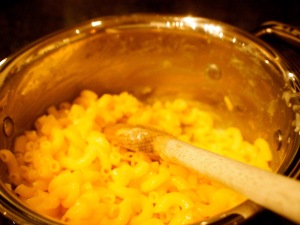Whenever I get a little bored, or I’m sitting in the bath, I delve into my i-pad espisodes of How to Cook Like Heston… I like the combination of science, technique and, ultimately, gastronomy – it always has my food brain working overtime… After a particularly late night hosting our annual Christmas quiz, I delved into the episodes again, and looking at my groaning cheese boards (yes, plural), thought I’d better get stuck into some of his cheese recipes.
Feeling slightly jaded, it was definitely the macaroni cheese which caught my attention… Not normally something I’d crave, but the thought of fat-laden carbs was definitely appealing to some bit of me! Mmmm…. Macaroni cheese – definitely comfort food! [There’s a bit more about the science of cheese melting at the bottom]
Ingredients
200g macaroni
½ tsp salt
15ml truffle oil
300ml dry white wine
300ml brown chicken stock, infused for 20 minutes with Berkswell cheese rind, keep warm
80g Spenwood cheese, finely grated [okay, I’m using Parmesan, a similar style]
10g cornflour [coating the cheese in cornflour prevents clumping together]
80g soft cream cheese
Black pepper
15g goat’s cheese, diced (I’m using the fabulous Fresco Angelico from Brockhall Farm!!)
Berkswell cheese, for gratinating (and this will be my Keene’s cheddar in this instance)
Method
- Preheat the grill. Place 400ml of water, the pasta and the salt in a pan over medium-high heat. Cook until the pasta is done and all of the water has disappeared. Toss the pasta with the truffle oil. [This releases the starch into the pan, rather than rinsing it away in any drained water]
- In a small saucepan, reduce the white wine over a high heat to 30ml. Add the warm chicken stock to the reduced wine. Mix the grated cheese with the cornflour and add to the pan. Stir until the cheese has been incorporated into the sauce, then add the pasta.
- Cook over a medium heat until the pasta is warmed through, then stir in the cream cheese. Season with freshly ground black pepper.
- Half fill an ovenproof baking dish with the pasta, sprinkle with diced goat’s cheese and add the remaining macaroni on top. [Heston bakes his inside a hollowed cheddar wheel]
- Sprinkle some more cheese on top and place under the grill to melt and gratinate the cheese. Serve immediately.
[Make sure you use the right macaroni – I happened to have small gluten-free macaroni made with maize and rise flour, which I’d bought in for my gluten-intolerant niece. It would have worked much better with a durum wheat, larger style macaroni.]
 |
| Coating the hard cheese in cornflour prevents it clumping together |
 |
| You can see the starch released around the sides of the pan |
 |
| Adding cream cheese increases the creaminess of the sauce |
 |
| You can clearly see the unmelted goat’s cheese cubes in the gratinated mac |
 |
| This dish is very rich, you wouldn’t want a huge helping!! |
 |
| Lot of cheese to use up! |
Part of the point of the show was to discuss the properties of different kinds of cheese, and their suitability for different dishes. Heston, Otto and Jockey each ironed a different type of cheese (yes, ironed), to test their melting points. The medium cheese melted on the lowest setting of the iron, but the fresh, soft goats cheese wouldn’t melt at all – the water merely evaporated and left a layer of cheese behind. The hard cheese did melt, but only after Heston moved the temperature up significantly.
The goal in most of his cheese recipes is to either release the fat and protein, or to impair that release. In this dish Heston coats the hard cheese in cornflour to restrict the release of the protein and fat – resulting in a much smoother sauce with no clumping. The sauce shouldn’t be boiled, as that would begin to release the fat and protein again, resulting in a less silky sauce.
The goat’s cheese was added in cubes to the dish precisely because it didn’t melt like the others – and the resulting pockets of spiky goats cheese enhance the overall cheesiness of the dish.
If you’re reading this outside of the United Kingdom, I think you can watch the relevant section on You Tube – but the copyright is protected inside the United Kingdom, sorry! You can find more of the recipes from the series here >

